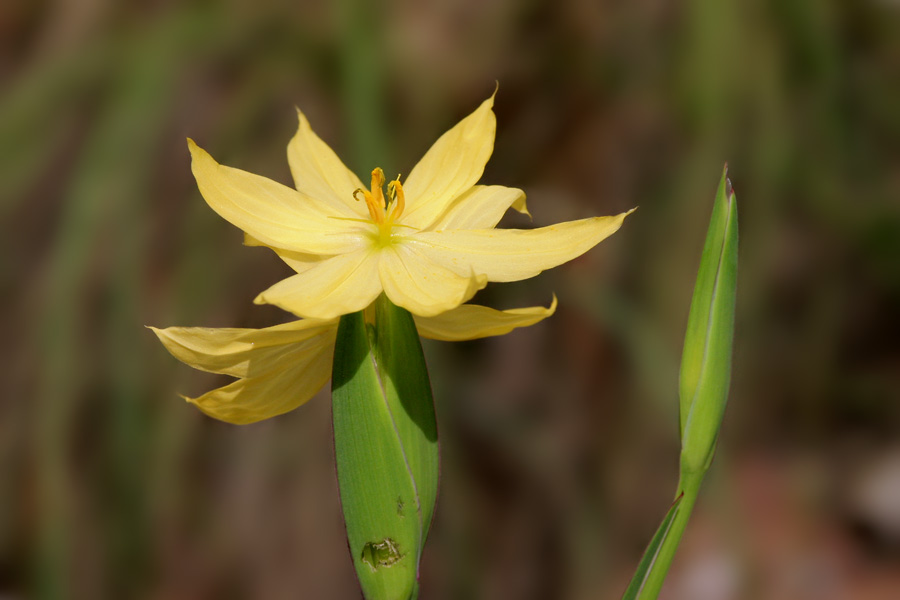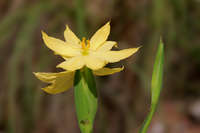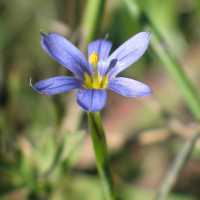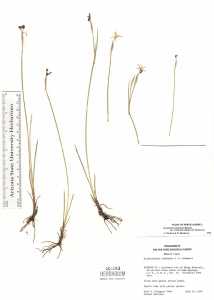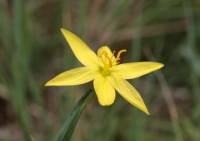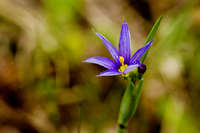Herbs, annual or perennial, often cespitose, rhizomatous (sometimes only obscurely, especially when cespitose) or not, sometimes with thickened, fleshy roots. Stems scapelike or branched, compressed, and 2-winged. Leaves 2-6, basal or basal and cauline, alternate, basally equitant; blade plane, ensiform, usually glabrous. Inflorescences rhipidiate, usually terminal (basal flowers occasionally produced in some montane populations), 1-11(-15)-flowered; spathes 2, opposed, green or with purplish tinge, equitant, equal or unequal, smooth to scabrous, margins hyaline, apex undifferentiated, acute to obtuse or bifid, margins of outer spathe usually connate basally. Flowers not fragrant, actinomorphic; tepals widely spreading to reflexed (S. minus and S. rosulatum with campanulate bases), ± distinct, bluish violet to light blue, white, lavender to pink, magenta, purple, or yellow, not clawed, subequal; stamens symmetrically arranged; filaments distinct, connate basally or into tube, tapering evenly to apex (basally inflated in S. rosulatum); anthers parallel, surrounding but not appressed to style branches; styles 3, erect, connate at least basally, filiform, not broad and petaloid, long, extending between stamens usually beyond anthers. Fruits capsular, ± globose, smooth to roughened by underlying seeds, apex usually rounded. Seeds many, globose to obconic or hemispheric; seed coat black, granular to rugulose. x = 8.
Sisyrinchium is a complex polyploid taxon in which the species are not always easily distinguished. When immature, plants of branched species appear to be simple-stemmed (internodes do not elongate until just before anthesis) and those of usually simple-stemmed species occasionally are branched. White flowers may occur in otherwise blue-flowered species, and vivipary occasionally occurs. Furthermore, vegetative characteristics, while distinctive in some species, may overlap greatly in wide-ranging species. Writers of past floras sometimes were unaware of such phenotypic plasticity, or were inconsistent in their use of terminology (spathes, for instance, have variously been called leaves or valves). Some taxonomists have thought differences too subtle and chosen to lump species (e.g., S. angustifolium and S. montanum have been considered synonymous by several authors).
Flowers and spathes provide the best characters but require fresh material or extreme care during pressing. Many older herbarium collections have been misidentified due to improper collecting/pressing techniques that obscured critical characters. Additionally, variability within populations makes accurate identification based on only one individual nearly impossible.
Chromosome counts can be useful in differentiating species but consistent numbers seem to be obtained only with meiotic counts. Some of the unusual counts reported in the literature were obtained with mitotic material or were from misidentified plants. A definite ploidal series seems to be evident, however, at least among the blue-flowered species. Limited breeding studies have shown that ploidal levels are strong barriers to reproduction (A. F. Cholewa and D. M. Henderson 1984; D. M. Henderson 1976). There is some indication, however, that true hybrids may exist (D. B. Ward 1959; D. S. Correll and M. C. Johnston 1970; G. Ajilvsgi 1984). Much more work, especially with molecular data and cladistic analyses, needs to be done to understand species relationships.
In eastern Texas (especially) and adjacent states, intermediates between Sisyrinchium ensigerum, S. pruinosum, S. langloisii, and perhaps S. sagittiferum can be found. These have been referred to S. texanum E. P. Bicknell (D. S. Correll and M. C. Johnston 1970), and Bicknell´s original description of that entity does mention a high degree of variability. Many of the specimens that we examined that were previously labeled S. texanum exhibit character states intermediate between those of S. langloisii and S. pruinosum or S. ensigerum. The types of S. texanum that we examined (Bray s.n., NY; Bush 32, NY; Hall 636, NY) would key to S. langloisii or S. pruinosum but exhibit several intermediate character states. Further, although K. L. Hornberger (1987, 1991) and D. S. Correll and M. C. Johnston (1970) considered S. texanum synonymous with S. sagittiferum (which they described as a branched species), E. P. Bicknell (1899, 1901) clearly indicated that the latter is unbranched, and thus it probably does not play a role in S. texanum. Much more work is needed to resolve the proper disposition of S. texanum and the true nature of this complex of southern species.
Characters critical for distinguishing species of Sisyrinchium are often found in floral material, requiring extra care in collecting and pressing. Accurate identification requires examining more than one individual in order to discount uncommon or atypical character states (generally not accounted for in this key). In branched individuals, leaves will be associated with one or more branches or peduncles that are narrower than the primary stem. Peduncles are morphologically indistinguishable from branches and are, hereafter, referred to simply as branches.
PLANT: Perennial or annual herbs, in ours generally caespitose.
ROOTS: fibrous, fine to moderately thickened, pale yellow to dark brown.
STEMS: 2-winged, simple or branched with 1-3 peduncles at uppermost nodes and 1(-2) leaf-like bracts at each node.
LEAVES: folded lengthwise in iris-like fashion but somewhat flexuous, mostly basal and distichous, the margins slightly hyaline basally.
INFLORESCENCE: an umbel with 2 spathe bracts, the lower (outer) bract enclosing the other (inner).
FLOWERS: 2-6, ephemeral, perfect, actinomorphic, perianth parts nearly alike (the 3 outer tepals slightly wider than the 3 inner), spatulate, oblanceolate, or elliptic, the apex generally apiculate and acute or obtuse to emarginate; filaments 3, nearly completely united or free; ovary inferior, 3-carpellate, the placentation axile.
FRUIT: a loclulicidal capslule.
SEEDS: 10-45, dark brown or black, generally spherical or angular, the surface nearly smooth, granular or reticulate.
NOTES: Ca. 80 spp. in the w hemisphere; 1 sp naturalized in New Zealand, another naturalized in the British Isles. (Greek: iris-like plant.) Cholewa, A.F., and Henderson, D.M. 1985. Brittonia 36:342-363; Henderson,D.M. 1976. Brittonia 28:149-176.
REFERENCES: Cholewa, Anita F. and Douglass M. Henderson. 1994. Iridaceae J. Ariz. - Nev. Acad. Sci. Volume 27(2), 215.
Perianth subrotate, the tep alike and spreading, retuse or abruptly aristulate, distinct or very shortly connate at base; filaments connate at least to the middle (to the top in our spp.); style-branches filiform, alternating with the stamens; capsule globose to obovoid, loculicidal; seeds black, globular, ±pitted; low, perennial, grass-like herbs, usually tufted from fibrous roots; lvs equitant, linear and mostly basal; scape-like stems 2-edged or 2- winged, simple or branched from the axils of lf-like bracts; fls delicate and fugacious, in umbel-like clusters from 2-valved spathes, blue to violet or pink, seldom white, rarely yellow, our spp. regularly with a yellow or greenish eye. Our spp. fl chiefly in May, but continue until Sept. 60Ѭ New World.
Gleason, Henry A. & Cronquist, Arthur J. 1991. Manual of vascular plants of northeastern United States and adjacent Canada. lxxv + 910 pp.
©The New York Botanical Garden. All rights reserved. Used by permission.


